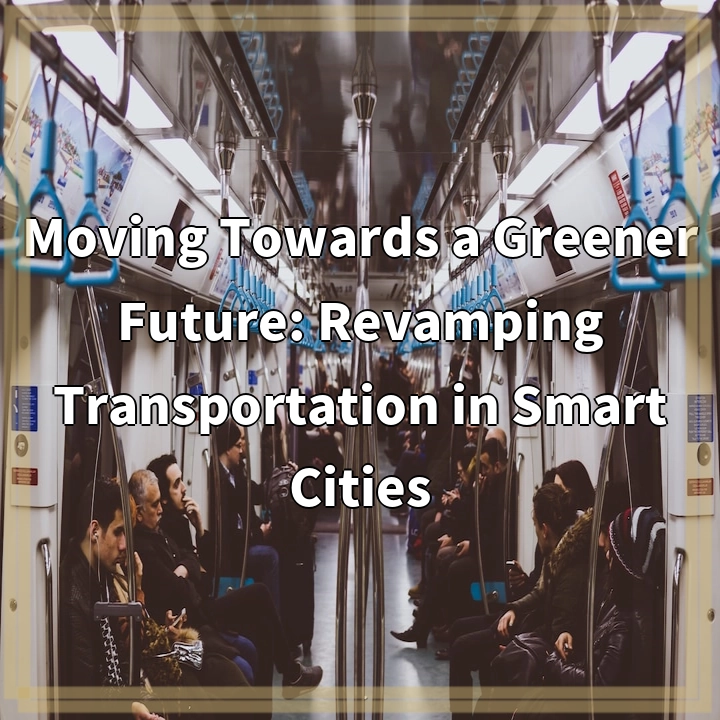
What it is:
In this blog post, we will explore the concept of moving towards a greener future by revamping transportation in smart cities. Smart cities are urban areas that leverage technology and data to enhance sustainability, efficiency, and quality of life for their residents. One key aspect of smart cities is the transformation of transportation systems to be more environmentally friendly and sustainable.
Real-World Problems:
As we strive to build greener transportation systems in smart cities, several real-world problems need to be addressed. These challenges can hinder progress and require innovative solutions to achieve sustainable and efficient urban mobility. Here are some of the common problems associated with moving towards a greener future in smart cities:
1. Limited Public Transportation Options:
One of the main challenges in revamping transportation systems is ensuring there are sufficient public transportation options available to residents. Many cities still heavily rely on private vehicles, leading to traffic congestion, increased carbon emissions, and air pollution. It is necessary to invest in the development and expansion of reliable and convenient public transportation networks, including buses, trains, trams, and bike-sharing systems.
2. Inadequate Infrastructure:
The current infrastructure in many cities is not designed to support greener transportation options. Lack of cycling lanes, pedestrian-friendly infrastructure, and charging stations for electric vehicles presents a barrier to adopting sustainable modes of transportation. Smart cities need to invest in infrastructure upgrades and redesign urban spaces to prioritize walking, cycling, and electric vehicle usage.
3. Affordability and Accessibility:
Green transportation solutions, such as electric vehicles, can often come with higher upfront costs, making them less accessible to the general population. Additionally, limited charging infrastructure can pose challenges for electric vehicle owners. It is crucial to ensure that sustainable transportation options are affordable and accessible to everyone, regardless of income or location.
4. Behavioral Change:
Shifting people’s behavior and encouraging them to adopt greener transportation options can be a significant challenge. Many individuals are accustomed to using private vehicles due to convenience or lack of awareness about alternative modes of transportation. Education and awareness campaigns, incentives, and convenient alternatives are necessary to drive behavioral change and promote the use of sustainable transportation options.
5. Interoperability and Integration:
Smart transportation systems rely on seamless integration and interoperability between different modes of transportation, such as buses, trains, car-sharing services, and bike-sharing platforms. Ensuring smooth connectivity, ticketing, and information sharing across various transportation options can be a complex task requiring coordination between different stakeholders, including transportation authorities, technology providers, and service providers.

Solutions for a Greener Future in Smart Cities:
To overcome the real-world problems associated with revamping transportation in smart cities, innovative solutions are required. Here are some potential strategies to achieve a greener and more sustainable urban mobility system:
1. Expanding Public Transportation:
Investing in the expansion and improvement of public transportation networks is crucial. This includes increasing the frequency and coverage of buses and trains, implementing dedicated cycling lanes, and introducing bike-sharing programs. By providing reliable and convenient alternatives to private vehicles, more residents are likely to embrace sustainable modes of transportation.
2. Upgrading Infrastructure:
Efforts should be made to upgrade the existing infrastructure to support greener transportation options. This includes building cycling and walking infrastructure, installing electric vehicle charging stations, and integrating smart technologies for better traffic management. Infrastructure upgrades will encourage the use of sustainable modes of transportation and make them more accessible to the public.
3. Ensuring Affordability and Accessibility:
To encourage widespread adoption of greener transportation solutions, affordability and accessibility must be prioritized. This can be achieved through subsidies for electric vehicles, incentivizing the use of public transportation through reduced fares, and ensuring inclusive transportation solutions for all sections of society, including low-income communities.
4. Promoting Behavioral Change:
Raising awareness and promoting behavioral change is key to encourage individuals to choose sustainable transportation options. Educational campaigns can highlight the environmental and health benefits of using public transportation, cycling, or walking. Incentives such as discounts, rewards, and priority parking for sustainable modes of transportation can also motivate behavior change.
5. Enhancing Interoperability and Integration:
To create a seamless and efficient transportation system, interoperability and integration between various modes of transportation are essential. This involves implementing integrated ticketing systems, real-time information sharing across different platforms, and collaborative partnerships between transportation service providers. By enabling easy transfer between modes of transportation, commuters are more likely to embrace greener options.















